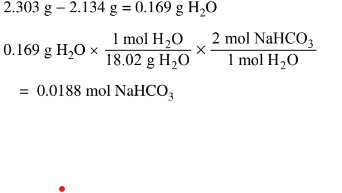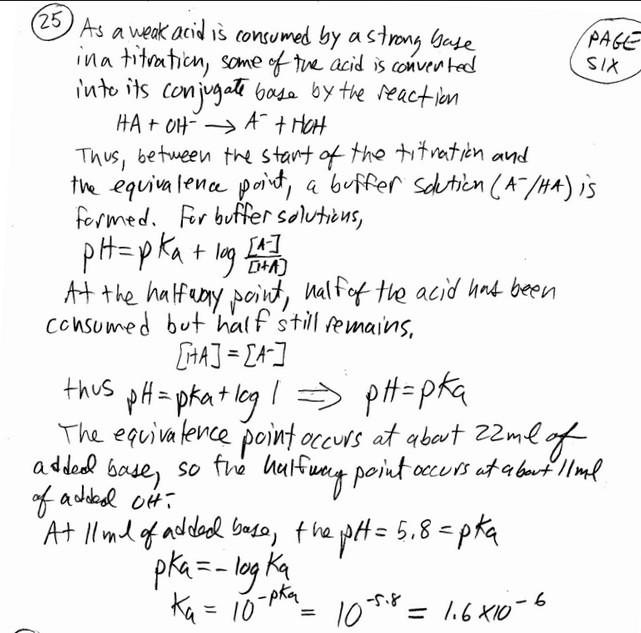Question
\(CH_3CH_2COOH(aq) + H_2O(l) \rightleftharpoons CH_3CH_2COO^ ̄(aq) + H2O^{+}(aq) \)
Propanoic acid, \( CH_3CH_2COOH\), is a carboxylic acid that reacts with water according to the equation above. At 25°C the pH of a 50.0 mL sample of 0.20 M \(CH_3CH_2COOH \) is 2.79.
(a) Identify a Brønsted-Lowry conjugate acid-base pair in the reaction. Clearly label which is the acid and which is the base.
(b) Determine the value of K for propanoic acid at 25°C.
(c) For each of the following statements, determine whether the statement is true or false. In each case, explain the reasoning that supports your answer. (i) The pH of a solution prepared by mixing the 50.0 mL sample of 0.20 M \(CH_3CH_2COOH\) with a 50.0 mL sample of 0.20 M NaOH is 7.00. (ii) If the pH of a hydrochloric acid solution is the same as the pH of a propanoic acid solution, then the molar concentration of the hydrochloric acid solution must be less than the molar concentration of the propanoic acid solution. A student is given the task of determining the concentration of a propanoic acid solution of unknown concentration. A 0.173 M NaOH solution is available to use as the titrant. The student uses a 25.00 mL volumetric pipet to deliver the propanoic acid solution to a clean, dry flask. After adding an appropriate indicator to the flask, the student titrates the solution with the 0.173 M NaOH, reaching the end point after 20.52 mL of the base solution has been added.
(d) Calculate the molarity of the propanoic acid solution.
(e) The student is asked to redesign the experiment to determine the concentration of a butanoic acid solution instead of a propanoic acid solution. For butanoic acid the value of pK is 4.83. The student claims that a different indicator will be required to determine the equivalence point of the titration accurately. Based on your response to part (b), do you agree with the student’s claim? Justify your answer.
▶️Answer/Explanation
(a) \(CH_3CH_2COOH\) and \(CH _3CH_2COO ^-\)
acid base
OR
\(H_2O^+\) and \(H_2O\)
acid base
(b) \([H_3O^+]=10^{-pH}=10^{-2.79}=1.6\times 10^{-3}\) M
\([CH _3CH_2COO^ ̄]=[H_3O^+]\)
AND
\([CH _3CH_2COOH]=20M-[H_3O^+]\) , OR \([CH _3CH_2COOH]\approx 0.20 M\)
\(K_a=\frac{[CH _3CH_2COO^ ̄][H_3O^+]}{[CH _3CH_2COOH]}=\frac{(1.6\times 10^{-3}M)^2}{0.20 M}\)
c.(i) False. The conjugate base of a weak acid undergoes hydrolysis (see equation below) at equivalence to form a solution with a pH>7.
\(CH _3CH_2COO^ ̄ + H_2O\rightleftharpoons CH_2CH_2COOH + OH ^-\)
c.(ii) True. HCI is a strong acid that ionizes completely. Fewer moles of HCI are needed to produce the same [H3O+] as the propanoic acid solution, which only partially ionizes.
(d) Let x = moles of propanoic acid
then \(x = (0.02052 L NaOH) \times \frac{0.173 mol NaOH}{1 L NaOH}\times \frac{1 mol acid }{1 mol NaOH} = 3.55 \times 10^{-3} mol propanoic acid \Rightarrow \frac{3.55 \times 10^{-3} mol acid}{ 0.02500 L acid} =0.142 M\)
OR
Since \(CH_3CH_2COOH\) is monoprotic and, at the equivalence point, moles \(H^+ = moles OH^-\), then
\(M_AV_A=M_BV_B\)
\(M_A=\frac{M_BV_B}{ V_A}= \frac{(0.173 M NaOH)(20.52 mL NaOH)}{ 25.00 mL acid} =0.142 M\)
(e) Disagree with the student’s claim From part (b) above, \(pK_a\), for propanoic acid is \(log(1.3 × 10^{_5}) = 4.89\). Because 4.83 is so close to 4.89, the pH at the equivalence point in the titration of butanoic acid should be close enough to the pH in the titration of propanoic acid to make the original indicator appropriate for the titration of butanoic acid.
Question.
\(2NaHCO_{3}(s)\rightarrow Na_{2}CO_{3}+CO_{2}(g)+H_{2}O(g)\)
\( NaHCO_3\)(s) (baking soda) decomposes upon heating to produce \(Na_2CO_3(s) \)and two gaseous products, as shown by the equation above.
(a) A student claims that the reaction is an oxidation-reduction reaction because the oxidation number of carbon changes. Do you agree with the claim? In your answer include the oxidation number of carbon in each of the three carbon-containing species in the reaction. The student conducts an experiment to determine the composition of a mixture of \(NaHCO_3\) (molar mass 84.01 g/mol) and \(Na_2CO_3\) (molar mass 105.99 g/mol). The student places a sample of the mixture into a preweighed test tube that is attached to a container that holds a drying agent. The student heats the test tube strongly with a Bunsen burner for 10 minutes, during which time all of the water produced by the reaction is captured by the drying agent. The following table shows the data the student recorded during the experiment.

(b) Calculate the number of moles of\( NaHCO_3(s)\) present in the mixture in the test tube before the reaction was initiated.
(c) Determine the mass percent of\( NaHCO_3(s)\) in the mixture.
(d) If the student spills some of the mixture out of the test tube after weighing the test tube and mixture and before heating, how would this error affect the mass percent of \(NaHCO_3\) calculated in part (c) ? Justify your answer. When a sample of pure\( Na_2CO_3 \)is placed in distilled water, the student observes that the pH of the solution increases significantly. This process is represented by the balanced net-ionic equation shown below.
\(CO_{3}^{2-}(aq)+H_2O{l}\rightleftharpoons HCO_{3}^-+OH^{-}(aq)\)
(e) The student prepares a 0.10 M \(Na_2CO_3(aq)\) solution and measures the pH of the solution to be 11.65.
(i) Calculate\( [OH^{-}]\) in the \(Na_2CO_3\)(aq) solution.
(ii) Write the expression for \(K_b\) for the carbonate ion.
(iii) Calculate the value of \(K_b \)for the carbonate ion. The student adds some 1.0 M Sr\((NO_3)_2\)(aq) to the 0.10 M\( Na_2CO_3(aq)\) and observes the formation of a precipitate.
(f) Write the balanced net-ionic equation for the reaction between Sr\((NO_3)_2\) and \(Na_2CO_3\) that produces the precipitate.
▶️Answer/Explanation
(a) No. The oxidation number of carbon is +4 in each of the three carbon-containing species.
(b)

(c) \(0.0188mol NaHCO_{3}\times \frac{84.01g NaHCO_{3}}{1molNaHCO_{3}}\frac{1.58g}{(17.648g-15.825g)}\times =86.7%\)
(d) The calculated mass percent would be smaller than the actual value. Less water would be collected, so there would appear to be less\( NaHCO_3\) in the sample.
(e)(i) \(pOH = 14.00 – 11.65 = 2.35\)
\([OH^−] = 10-2.35 = 4.5\times 10^-{3}\)
e(ii) \(k_b=\frac{[HCO_{3}^{-}][OH^-]}{CO_{3}^{2-}}\)
e(iii) \(K_b=\frac{(4.5\times 10^{-3})\times (4.5\times 10^{-3})}{0.10-(4.5\times 10^{-3})}\approx \frac{(4.5\times 10^{-3})^2}{0.10}= 2.0\times 10^{-4}\)
(f) \(Sr^{2+}CO_{3}^{2-}\rightarrow SrCO_{3}\)
Question
25.0 mL sample of a solution of a monoprotic acid is titrated with a 0.115 M NaOH solution. The
titration curve above was obtained. The \(K_a\) of the monoprotic acid is about __________.
▶️Answer/Explanation
Answer:

